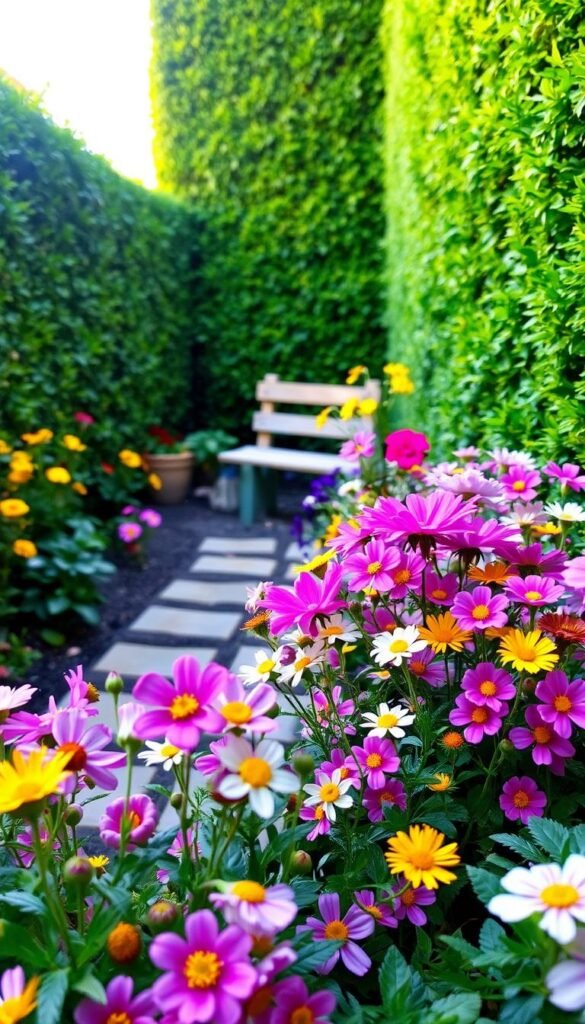Transforming cozy outdoor areas into vibrant escapes doesn’t require acres of land—just smart planning. Whether you’re working with a balcony or a modest backyard, strategic layouts can make your space feel expansive while bursting with life. The secret? Balancing greenery and functional elements without overcrowding.
Imagine a layout where every plant and pathway serves a purpose. Experts recommend dedicating half your area to plants and seating, reserving the rest for walkways or decorative surfaces. This 50/50 split creates harmony, letting your eyes move freely through the design. Color plays a role too: cohesive palettes and long-blooming varieties keep the view lively yet uncluttered.
Discover how repetition of shapes or textures adds rhythm to your layout, while focal points like a statement planter draw attention upward. You’ll learn to borrow ideas from professional landscapes, adapting them to your unique needs. Even subtle choices—like mirror placements or vertical gardens—can trick the eye into perceiving more depth.
Ready to rethink your patch of green? We’ll show how thoughtful decisions in compact areas create outsized visual impact, turning limitations into creative opportunities.
Embracing Vertical Design in Your Compact Outdoor Space
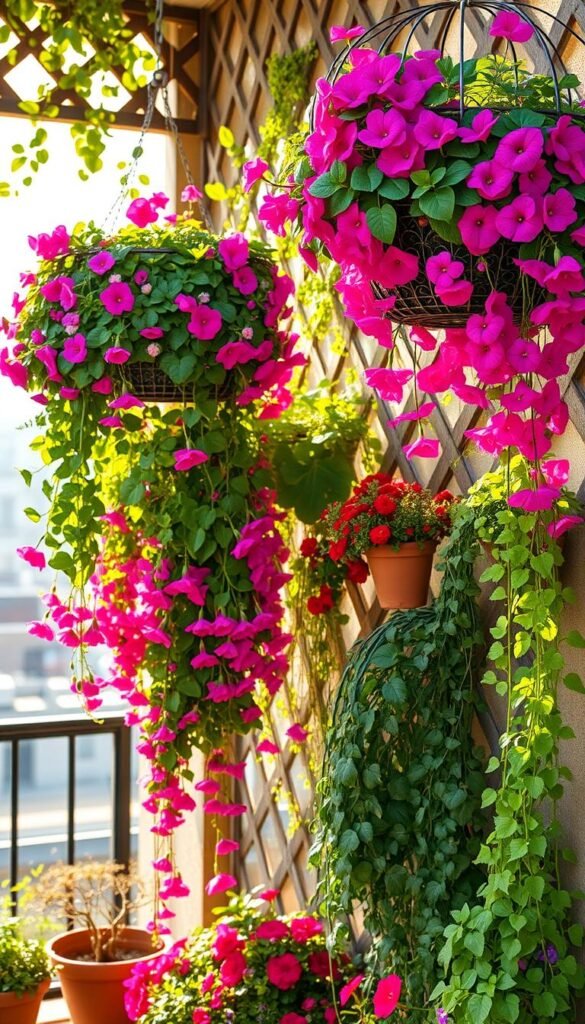
Elevating your greenery upward unlocks hidden potential in cramped areas. By directing growth vertically, you create layered interest while preserving precious floor space. This approach works wonders for balconies, patios, or narrow yards where traditional planting isn’t feasible.
Utilizing Hanging Baskets and Wall Planters
Hanging baskets transform blank walls into blooming canvases. Opt for trailing varieties like calibrachoa or lobelia—their cascading stems soften edges while maximizing color. For shaded spots, ferns or herbs thrive in mounted containers, as seen in these vertical gardening solutions.
Wall-mounted systems let you experiment without commitment. Try seasonal swaps: spring pansies, summer petunias, or autumn ivy. “Vertical planting isn’t just practical—it’s a chance to showcase your personality,” notes urban gardener Lila Torres.
Creative Trellis and Pergola Ideas
Climbing plants like jasmine or clematis turn functional structures into living art. Install slim trellises between windows or train vines across pergola beams. These elements draw eyes upward, creating illusions of height—perfect for disguising unsightly fences or adding privacy.
Pair structural elements with colorful container arrangements at their base. A clematis-covered archway paired with dwarf hydrangeas makes even postage-stamp areas feel curated. Remember: vertical gardens need consistent watering—drip systems prevent parched plants.
Clever Container and Pot Gardening Solutions

Your patio becomes a plant paradise when containers do the heavy lifting. These movable ecosystems let you curate color and texture while keeping floor areas open. The trick? Using strategic placement and scale to create rhythm without chaos.
Choosing the Right Containers for Your Plants
Material matters more than you think. Terra cotta breathes well but dries quickly—perfect for succulents. Glazed ceramic retains moisture for thirsty hydrangeas. “Always match the pot’s drainage needs to your plant’s roots,” advises horticulturist Mara Jensen.
Go big or go home. One 24-inch planter makes a stronger statement than six tiny pots. Fill it with layers: evergreen shrubs at the back, trailing ivy at the edges, and seasonal blooms up front. This approach saves space while delivering year-round interest.
Get creative with unexpected vessels. Old toolboxes, woven baskets, or repurposed crates add personality. Just drill drainage holes and line with landscape fabric. Group three varied-height containers near seating areas to form inviting vignettes that guide the eye.
Remember: lightweight resin pots simplify rearranging when sunlight patterns shift. Pair them with wheeled stands for effortless seasonal migrations. Your garden stays fresh, and your back stays happy.
Dual-Purpose Garden Furniture for Maximum Utility
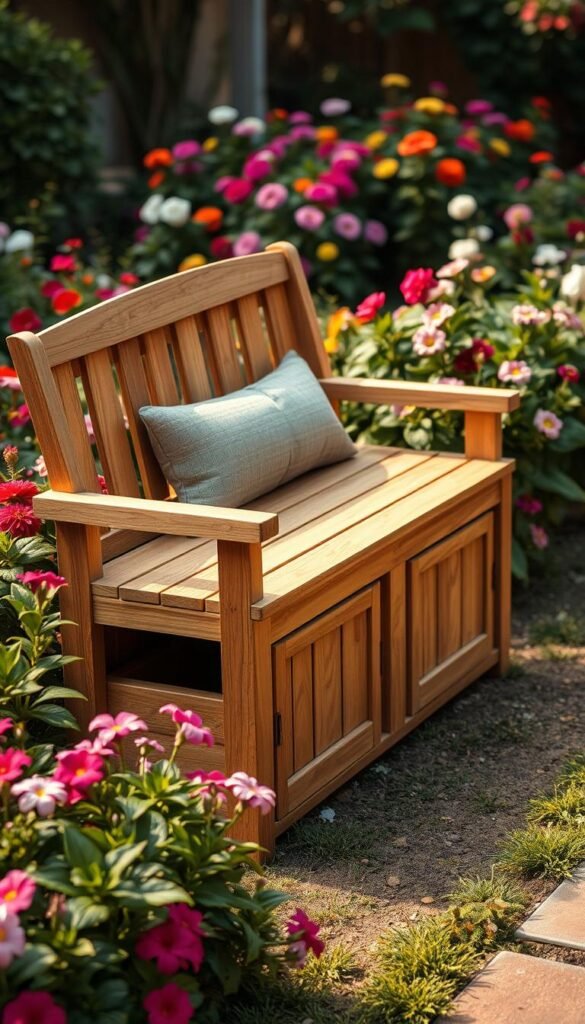
Smart furniture choices can transform your limited patio into a functional oasis. Multi-use pieces eliminate the need to choose between comfort and practicality—they deliver both while preserving precious square footage.
Bench Designs with Built-In Storage
Corner benches do double duty as hidden storage units. Tuck gardening gloves, cushions, or tools inside weatherproof compartments while maintaining a clean aesthetic. Urban designer Rachel Carter notes: “Built-in seating along boundaries creates flow—your eye skims along the edges, making the area feel larger.”
Position seating against fences or walls to free up central space for activities. A curved bench hugging your patio’s perimeter provides ample room for a compact dining set or decorative pots. Add lift-up lids with hydraulic arms for easy access to stored items.
Try these space-saving combos:
- Planter-top benches showcasing trailing petunias
- Nesting tables that collapse when not in use
- Ottomans with removable tops for blanket storage
DIY enthusiasts love repurposing old dressers into outdoor consoles. Remove drawers, add weather-resistant paint, and install sliding bins for seasonal decor. This approach costs less than store-bought options while fitting exact dimensions.
Your furniture can define zones too. A storage bench separates dining and lounging areas without bulky dividers. Choose materials matching your garden’s style—rustic wood for cottage themes or powder-coated metal for modern spaces.
Light-Colored Landscaping and Hardscaping Techniques
Brighten your outdoor area with clever color choices that trick the eye into seeing more space. Light-toned materials like pale gravel or limestone reflect sunlight, making shaded corners feel airy. This simple swap can help make even the coziest patio appear expansive.
Horizontal patterns work magic in narrow zones. Rectangular pavers laid lengthwise stretch the view, while light gray concrete or sandy-toned bricks blur boundaries. Pair these with vertical planters to balance proportions without crowding walkways.
Paint transforms more than walls. A soft cream fence becomes a backdrop that makes greenery pop, while pale blue garden structures mimic sky tones. “Light surfaces act like mirrors for daylight,” explains landscape designer Elena Martinez. Materials matter too—opt for reflective finishes like polished stone or light wood stains.
Try these space-enhancing strategies:
- Lay pea gravel paths that brighten underfoot
- Install raised beds with whitewashed edges
- Use light mulch around plants to unify the design
For budget-friendly upgrades, mix affordable gravel with creative design ideas like painted cinder block planters. Terraced levels add depth, letting you grow more without clutter. Remember: every pale surface works together to bounce light and expand your outdoor oasis.
Small Flower Garden Solutions: Maximizing Tight Spaces with Big Impact
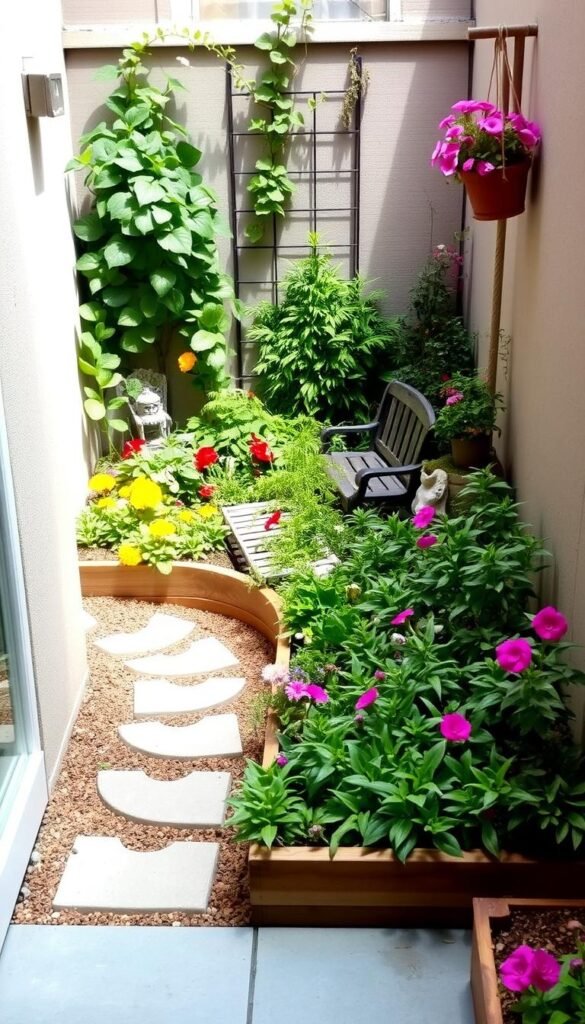
Crafting a captivating outdoor retreat begins with observing how experts manipulate space and scale. Award-winning displays at events like the Philadelphia Flower Show reveal clever tricks for making modest areas feel expansive. Professional designers often use curved pathways and layered planting to guide visitors through miniature landscapes.
Learning From Horticultural Masters
Top designers emphasize the 50/50 balance between greenery and surfaces. “Half your area should invite exploration, while the rest provides breathing room,” explains landscape architect Fiona Collins. This ratio prevents visual clutter while allowing colorful flowers to shine against clean stone or wood.
Smart Space Allocation Strategies
Three core principles transform cramped plots:
- Curved walkways that hide endpoints, creating curiosity
- Plants spilling onto paths from central beds
- A focal bench or sculpture as a journey’s reward
Try adapting concepts from grand estates to your patio. A Versailles-inspired parterre becomes charming when scaled down in containers. Mirror placements behind climbing roses double the sense of depth without extra square footage.
Successful garden design makes every element work overtime. That ornamental urn? It stores tools. The winding gravel path? It cleverly conceals the property line. With these insights, your compact oasis becomes a masterclass in intentional living.
Innovative Storage Ideas and DIY Garden Hacks
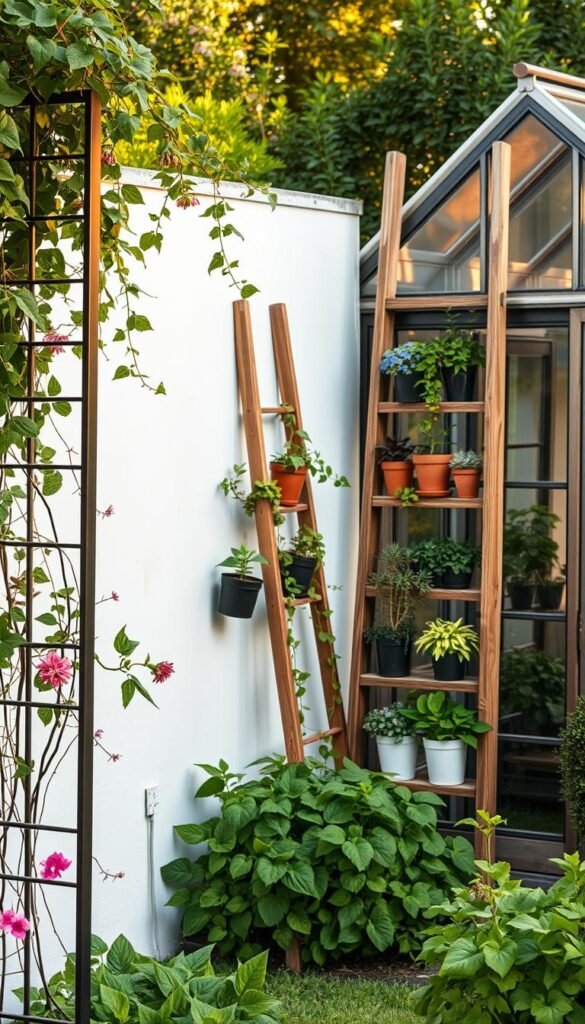
Unlock hidden potential in your outdoor area by reimagining overlooked nooks. Clever organization turns dead zones into functional assets while keeping tools and supplies within reach. Let’s explore how to store more without shrinking your growing space.
Vertical Shelving and Under-Shed Space
Maximize vertical real estate with multi-level shelving systems. Attach jar lids to shed ceilings—screw glass containers upside-down for instant storage. These transparent holders keep plant labels, twine, or seeds visible yet dust-free. Urban gardener Marco Diaz shares: “My under-stair cubby stores six toolkits while hosting climbing strawberries.”
Reclaim neglected spots under decks and porches. Install sliding bins on rails for seasonal decor or potting soil. Waterproof curtains can shield items from rain while maintaining airflow. For quick access, try these space-saving setups:
| Storage Type | Materials Needed | Best Uses |
|---|---|---|
| Under-Shelf Jars | Mason jars, screws | Small accessories |
| Wall-Mounted Grids | Wire panels, S-hooks | Hand tools |
| Under-Deck Drawers | Weatherproof slides | Bulky items |
Transform fences into storage walls with modular planters. These dual-purpose systems hold herbs in front and trowels behind. Check out these backyard storage ideas for inspiration using repurposed crates or pallet racks. A green wall with built-in pockets stores seed packets while showcasing basil and marigolds.
Remember: elevated storage keeps floors clear, making your area feel larger. Use waterproof labels and transparent bins to maintain order. With these tricks, every inch works harder—leaving more room for what you love.
Low Maintenance and Long-Season Planting Strategies
Creating a lush retreat shouldn’t demand endless hours of upkeep. Strategic plant choices let you enjoy vibrant colors and textures without constant tending. Focus on varieties that thrive in your climate while delivering multi-season interest.
Repeat-Flowering Plants for Continuous Bloom
Lavender and coneflowers keep your space lively from spring through frost. These hardy perennials bounce back after blooming, requiring minimal pruning. Pair them with drought-tolerant salvias for fiery red accents that attract pollinators all summer.
Structural Planting With Evergreen Shrubs
Boxwood hedges or dwarf hollies provide year-round backbone to your design. Their dense foliage hides fading annuals while framing seasonal stars like tulips or chrysanthemums. “Evergreens act as living sculptures,” notes landscaper Tessa Nguyen. “They anchor the space so fleeting blooms can shine.”
Combine these approaches for effortless beauty. Layer low-care grasses beneath flowering shrubs—their movement adds energy without extra work. With smart selections, your outdoor haven stays captivating through every season.

